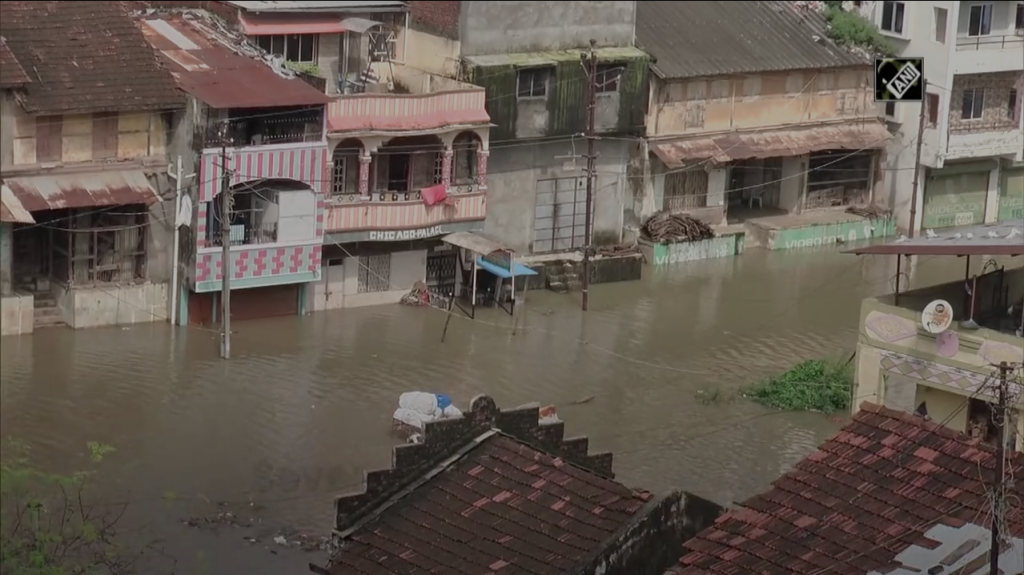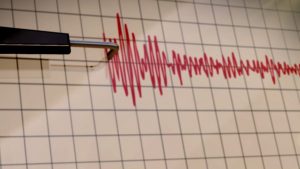September 2, 2020 SANDRP
Sardar Sarovar Dam (SSD) operators are operating the dam callously, almost cruelly, without consideration of the impact of the operation in the downstream area. Till Saturday-Aug 29, 2020 early, they were not releasing any water from the spillway gates of the dam, in spite of sufficient actionable information at least since Aug 26 that rainfall is hugely increasing in upstream Narmada basin. By Aug 29 night they were releasing up to ten lakh cusecs – Cubic Feet Per Second (28320 cumecs or Cubic Meters per second) of water. Three days later, in the evening of Tuesday, Sept 1, they closed the spillway gates, thus stopping all releases from the spillway. During these 3-4 days, massive quantities were released, up to 30 000 cumecs through spillways, and nothing before or after! It created massive flood disaster all along the downstream from Gaudeshwar to Bharuch, but the Sardar Sarovar Project (SSP) authorities, Gujarat government seem least bothered.
It’s in fact double disaster: it created an avoidable flood disaster. The second disaster was basically in terms of the loss as it also meant that the water that could have been released into the river over longer period, could not be used for that purpose.
Could they have avoided this kind of massive, disastrous flood flow for the downstream area for 3-4 days and instead staggered the releases over longer period, which, in stead of of creating a disaster, could have helped the downstream river and area over a longer period? Was there actionable information available with SSP authorities to take such advance releases of lower quantum? Did they use that information? Who are responsible? What action can and should be taken?
The downstream disaster The releases were so heavy on Aug 29 that TOI reported: “About 21 villages located close to the embankment of Narmada river in Jhagadia, Bharuch and Ankleshwar talukas in Bharuch district have been put on alert… A team of National Disaster Response Force (NDRF) too has been put on stand-by in the district for rescue and relief work following the flood alert issued by the Bharuch district administration on Saturday… District collector of Bharuch, Dr MD Modiya said, “People in low-lying areas in Jhagadia, Bharuch and Ankleshwar have been advised not to venture near the river and stay alert. The administration is fully prepared to meet any eventuality.””
On Monday, ANI reported on Monday, Aug 31, 2020: “10 lakh cusecs of water has been released from the Sardar Sarovar Dam today. It has impacted at least 30 villages near the dam. We have shifted 4977 people who were affected by the flood like situation. MD Modiya, the district magistrate, Bharuch said currently the water level of the Golden Bridge is at 32.68 ft.”
According to another set of Gujarati reports, (following opening of 23 of the 30 spillway gates of SSD), for the 7th time in last 50 years, water level crossed 34 feet and reached 35.17 feet (10.72 m). Livelihoods of tens of thousand is affected, at least 6595 people had to be shifted for safety. Boats were plying in Old Bharuch city streets. Water has entered at least 4000 shops, leading to massive damages. Crops over at least 20 000 ha have been destroyed. Narmadeshwar temple at Garudeshwar got washed away in the floods.
The Video from The Times of India shows how Bharuch areas are flooded.
CWC also tweeted how SSP releases lead to floods in downstream areas: https://twitter.com/CWCOfficial_FF/status/1300786574376996864
How did SSP authorities operated the dam? From the information available from CWC (Central Water Commission) Flood Forecasting, NCA (Narmada Control Authority) daily bulletins and other available information, we can understand how SSD was operated during this episode. There are contradictory informations in some instances between these sources, in which case we have gone by what CWC FF hydrographs as that is more detailed information compared to NCA bulletins, which give only daily average figures.
The NCA bulletin of Aug 28 also reported zero releases from SSD spillways. NCA bulletin of Aug 29 reported (applicable for 0800 hours that day) spillway release of 3231.4 cumecs and when we add the RBPH (River Bed Power House) releases of 1114.6 cumecs, we have a total release to the river of 4346 cumecs, this is possibly the average figure for the 24 hrs ending at 0800 hrs on Aug 29. Similarly releases to the river for Aug 30, Aug 31, Sept 1 and Sept 2 are reported as: 17343 cumecs, 25726 cumecs, 29887 cumecs and 23410 cumecs respectively.
The following SSD hydrograph gives the latest situation starting from Aug 30 to Sept 2.

The NCA bulletins also tell us that the SSP power houses were producing NO power on Aug 2, paltry 0.509 MU on Aug 26, 10 MU on Aug 27 and produced a peak of 26.91 Million Units on Sept 2, when power houses released maximum 1552 cumecs. This again shows underutilization of the power stations, if they had operated them optimally before Aug 29, it would have helped reduce the water level. Average water release from SSD (including spillways, power houses and Head Regulator) on Aug 25, 26, 27 and 28 were just 4.4 cumecs, 117 cumecs, 688 cumecs and 1114 cumecs, which shows that SSP was just hoarding water during these and earlier days. If the dam had released regular greater quantity of water, that would not only helped the people, river and ecosystem but also would have helped avoid the disaster.
Information that SSP authorities could have used to take advance action The IMD provides daily district wise rainfall figures for the 24 hrs ending at 0830 hours every day. If we see these figures for Aug 27 (rainfall happening on Aug 26), the rainfall in some of the Narmada Valley districts were: Dindori: 416% above normal; Jabalpur: 315% above normal; Mandla: 254% above normal; Katni: 147% above normal and Seoni: 135% above normal. So this rainfall on Aug 26, the information about which should clearly be monitored by SSP authorities since that rainfall would ultimately result in inflows in SSP, was clear, actionable information.
Similarly, rainfall in some of the Narmada valley districts in MP reported by IMD Aug 28 morning (rainfall on Aug 27) was even bigger warning: Narshimapura: 152.6 mm; Raisen: 110.5 mm; Hoshangabad: 81.8 mm; Balaghat: 83 mm; Chhindwara: 68.5 mm; Dindori: 49.8 mm; Jabalpur: 58.9 mm; Mandla 74.2 mm; Seoni: 67.4 mm. The rainfall of Aug 27 was another major warning.
Rainfall reported by IMD on Aug 29 morning (rainfall on Aug 28) in some of the Narmada Valley districts went up further: Betul: 142.4 mm; Harda: 111.1 mm; Hoshangabad: 191.1 mm; Raisen: 114.5 mm; Sehore: 87 mm; Balaghat: 90.7 mm; Chhindwara: 250.6 mm; Nrsimhapur: 138.4 mm; Seioni: 139.7 mm. Such heavy rainfall on Aug 28 was another major warning.
This is about actual rainfall. In fact, IMD forecasts for rainfall were available even earlier that these respective dates.
CWC also provided warning and advisories that SSP authorities clearly ignored CWC daily reports and advisories provided warnings in a number of way, some important asepcts are noted below.
26.08.20 Rainfall warning for SSP/ SSP/ Tawa/ Barna: NO
Bargi: Yes.
26.08.20 Inflow forecast for ISP and OSP falling.
27.08.20: Inflow forecast: For ISP and OSP: Steady; For Bargi: Rising
27.08.20 CWC advisories included: “Rivers …Narmada …, East Madhya Pradesh… are expected to rise rapidly due to forecasted extreme rainfall in next 2 days. … Bargi Dam… in Madhya Pradesh … are expected to get heavy inflows. Close watch is to be maintained in Districts Shahdole, Balaghat, Jabalpur, Mandla, Seoni, Chhindwara, Betul in Madhya Pradesh”. Flood alerted districts along Narmada included districts along Narmada.
Rainfall warning reservoirs included: Bargi, ISP, Tawa, Barna: Yes. SSP: No.
28.08.20 Inflow forecast: ISP 3200 (Rising); OSP 4900 (Rising); Bargi 4000 (Rising); Tawa 6000 (rising);
28.08.20 CWC advisories included: “Rivers Narmada, … in Madhya Pradesh, …are expected to rise rapidly due to forecasted very heavy rainfall in next 2-3 days. … Bargi Dam, Barna Dam, Tawa Dam, Indira Sagar Dam, Omkareshwar Dam, … in Madhya Pradesh, … are expected to get heavy inflows. Close watch is to be maintained in Districts Shahdole, Balaghat, Jabalpur, Mandla, Seoni, Chhindwara, Betul, Narasimhapur, Raisen, East & West Nimar, Dhar in Madhya Pradesh, …”
“Rivers Narmada, … in Gujarat, … are expected to rise due to forecasted heavy to very heavy rainfall in the next 3 days. … Sardar Sarovar Dam … in Gujarat are expected to get increased inflows.”
Rainfall warning for dams: Barna, Bargi, ISP, Tawa YES (RED), SSP: Yes (Orange).
While the CWC forecasts and advisories could have been clearer, sharper and better, this was another set of information that SSP authorities could have used for advance releases from SSD.
How advance action would have avoided the disaster It is clear from above that SSP authorities had sufficient information to take advance action and start releasing water from the dam from Aug 26 evening, if not earlier. If they had gradually started water releases and built up to say 4 lakh cusecs (11300 cumecs), they could have continued to release this moderate quantity of water for the next say 10 days starting from Aug 26 and that would have taken care of all the flows that SSD received during Aug 29-Sept 1. The water level at SSP may have risen a bit temporarily. This would have meant no flood disaster in the downstream area. And in stead, the 4 lakh cusecs water that would have flown in this 160 km stretch of river would have benefited the river, groundwater and eco system in large number of ways.
The concerned SSP authorities and Gujarat govt officials must be held accountable. There is also a need to change the monitoring and standard operating procedure of the Sardar Sarovar Dam. One hopes the Gujarat Government, NCA, CWC, National Disaster Management Authority and judiciary takes note of this.
Himanshu Thakkar (ht.sandrp@gmail.com)
END NOTES:
[i] https://timesofindia.indiatimes.com/city/surat/21-bharuch-villages-on-alert-after-sardar-dam-opens-gates/articleshow/77827120.cms
[ii] https://www.aninews.in/news/national/general-news/gujarat-floods-low-lying-areas-affected-after-water-released-from-narmada-dam20200831224345/
[iii] https://watchgujarat.com/india/gujarat/bharuch/gujarat-narmada-sardar-sarovar-dam-water-storage-capacity-6-25-crore-gujarati/, https://watchgujarat.com/india/gujarat/bharuch/watchgujarat-bharuch-flooded-people-rescued-water-logged/, https://watchgujarat.com/india/gujarat/bharuch/gujarat-narmada-garudeshwar-mahadev-temple-drwan-into-narmada-river-live-video/
[iv] https://timesofindia.indiatimes.com/videos/city/ahmedabad/watch-low-lying-areas-in-gujarats-bharuch-face-intense-flooding/videoshow/77857646.cms
[v] http://ffs.tamcnhp.com/
[vi] http://nca.gov.in/dsr.htm



